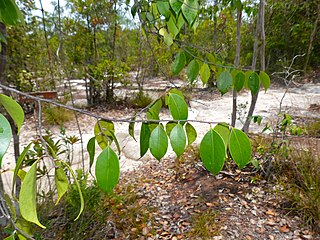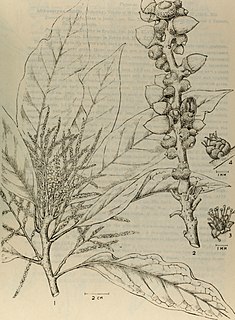Canarium littorale is a tree found in tropical Asia and is a member of the incense tree family Burseraceae. The specific epithet littorale is from the Latin meaning "of the seashore", referring to its habitat.
Maranthes corymbosa is a tree in the family Chrysobalanaceae. The specific epithet corymbosa is from the Greek meaning "cluster", referring to the clustered inflorescences.

Parastemon urophyllus is a tree in the family Chrysobalanaceae. The specific epithet urophyllus is from the Greek meaning "tail leaf", referring to how the leaf tapers to a sharp point.
Helicia excelsa is a plant in the family Proteaceae. It grows as a tree up to 20 metres (70 ft) tall, with a trunk diameter of up to 25 centimetres (10 in). The bark is dark grey to blackish. Inflorescences bear up to three reddish brown flowers. Fruit is black, ellipsoid, up to 3 centimetres (1 in) long. The specific epithet excelsa is from the Latin meaning "lofty", referring to the tree's growth. Habitat is forests from sea level to 1,700 metres (5,600 ft) altitude. H. excelsa is found in Bangladesh, Burma, Thailand, Malaysia and Indonesia.
Helicia maxwelliana is a plant in the family Proteaceae. It grows as a treelet up to 3 metres (10 ft) tall. The twigs are dark brown. The flowers are reddish brown. The fruit is black, round, up to 2.5 centimetres (1 in) in diameter. Its habitat is montane forest at 1,600 metres (5,200 ft) to 1,700 metres (5,600 ft) altitude. H. maxwelliana is endemic to Borneo.
Helicia pterygota is a plant in the family Proteaceae. It grows as a shrub or small tree up to 7 metres (20 ft) tall, with a stem diameter of up to 6 centimetres (2 in). The bark is brownish. The specific epithet pterygota is from the Greek meaning "winged", referring to the pedicel. Habitat is forests from 1,000 metres (3,300 ft) to 1,800 metres (6,000 ft) altitude. H. pterygota is endemic to Borneo where it is confined to Mount Kinabalu in Sabah.
Canarium hirsutum is a tree in the family Burseraceae. The specific epithet hirsutum is from the Latin meaning "bristly", referring to the rough hairs of the fruit.

Cratoxylum glaucum is a plant in the family Hypericaceae. The specific epithet glaucum is from the Latin meaning "blue-green", referring to the colour of the leaf underside.

Strombosia ceylanica is a tree in the family Olacaceae. The specific epithet ceylanica is from the Latin meaning "of Ceylon".

Melicope triphylla is a plant in the family Rutaceae. The specific epithet triphylla is from the Greek meaning "three leaf", referring to the trifoliolate leaves.
Lithocarpus bennettii is a tree in the beech family Fagaceae. It is named for the English botanist John Joseph Bennett.
Lithocarpus blumeanus is a tree in the beech family Fagaceae. It is named for the German-Dutch botanist Carl Ludwig Blume.
Lithocarpus confragosus is a tree in the beech family Fagaceae. The specific epithet confragosus is from the Latin meaning "uneven", referring to the cupule wall surface.
Lithocarpus daphnoideus is a tree in the beech family Fagaceae. The specific epithet daphnoideus is from the Greek meaning "like Daphne", referring to the genus Daphne and its leaves.

Lithocarpus elegans is a tree in the beech family Fagaceae. The specific epithet elegans is from the Latin meaning "elegant", referring to the acorns and cupules.
Lithocarpus gracilis is a tree in the beech family Fagaceae. The specific epithet gracilis is from the Latin meaning "slender", referring to the twigs.
Lithocarpus hystrix is a tree in the beech family Fagaceae. The specific epithet hystrix is from the Greek meaning "spiny", referring to the cupule.
Lithocarpus lampadarius is a tree in the beech family Fagaceae. The specific epithet lampadarius is from the Greek lampas meaning "torch", referring to the use of its twigs as torches for fishing in Peninsular Malaysia.
Lithocarpus leptogyne is a tree in the beech family Fagaceae. The specific epithet leptogyne is from the Greek, referring to the slender female flower.
Lithocarpus lucidus is a tree in the beech family Fagaceae. The specific epithet lucidus is from the Latin meaning "shining", referring to the acorn and leaf surface.




